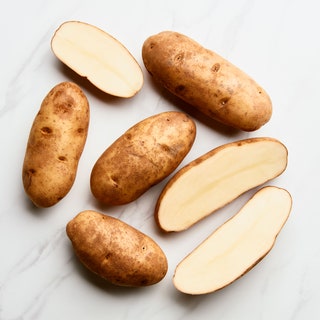12 Types of Potatoes and How to Cook With Them
Affordable, versatile, and accessible, the humble potato is one of the most relied-upon food crops in the world—the third-most important, according to the International Potato Center. They’re relatively easy to grow in a multitude of climates and conditions. Understanding the nuances (and names) of the thousands of different types of potatoes out there, though? Not quite as easy.
From the misconceptions around yams and sweet potatoes (which, yes, are two different things, neither technically a potato) to the sheer vastness of potato varieties, there’s considerable complexity around this seemingly simple label slapped on to such a broad range of root vegetables. But knowing the differences between all the kinds of potatoes you may encounter means you can make the most of their individual qualities for superior potato dishes, like the silkiest, butteriest mashed potatoes, the crispiest potato chips, and crave-worthy sweet potato casseroles, gratins, and beyond.
The dirt on starchy versus waxy:
Nick Hukezalie, chef de cuisine of Blue Hill at Stone Barns, offers an overarching approach to deciding how to use any given potato: “Culinarily, we break potatoes down into two main categories: Floury [a.k.a. starchy] potatoes and waxy potatoes,” he says.
“Whenever you’re thinking about a dish made from floury potatoes, think of anything that has either a crispy-crunchy texture or a light and fluffy texture. A french fry is a perfect example: It has that fluffy interior and that crispy outside.” For applications like gnocchi, potatoes with high starch content add a desirable lightness due to their low water content. Using a waxy potato to make gnocchi would result in a gummy mess.
Waxy potatoes offer benefits of their own, and Hukezalie says these denser varieties offer creamy texture and a more stable structure. “Starchy potatoes tend to break down when you boil them,” he says. Waxy potatoes are more likely to keep their shape, making them a better fit for stews or potato salads, as well as baked dishes, like scalloped potatoes.
Dig deeper into the world of tubers with a breakdown of some popular varieties of potatoes, many of which you’ll likely find in your local grocery store. But note, Jason Grauer, director of farm innovation for Stone Barns Center, suggests seeking out regionally bred or adapted potatoes from nearby farmers markets, as experimenting with these distinct local discoveries can lead to even more delicious results.
How to store potatoes:
Buy what you know you’ll cook within a week to 10 days, says Frank Muir, president of the Idaho Potato Commission. Storing potatoes in an open paper bag is the best way to keep out light and allow air to circulate. Keep potatoes in your pantry, cupboard, or basement—wherever it’s cool, dry, and dark. But keep them out of the refrigerator, which would adversely affect their flavor and texture.
How to prevent potato discoloration:
Some recipes suggest placing sliced potatoes in cold water until you’re ready to cook them. While this works, it’s not great for every recipe. For something like latkes, you’re counting on the starch to hold the shreds of potato together; soaking the spuds will rinse that precious starch away. In these cases, the best answer is to work fast (and don’t worry too much about a small amount of browning, the frying will turn it golden anyway).
Can you still eat sprouted or green potatoes?
A potato that has started to sprout “is nature's way of saying, ‘You should’ve eaten me already.,’” says Muir. “It’s saying it wants to grow more potatoes.” That said, the potato is still edible. Just cut off any sprouts—and don’t wait any longer to cook it.
A green tinge on the skin of a potato means that chlorophyll has formed. This can happen when a potato is exposed to light—especially fluorescent light, Muir said. Supermarkets often cover their potato bins overnight to block out the light and prevent greening. While the potato likely isn’t harmful to consume, it may taste bitter, so you’ll want to peel or cut away the green areas first.
12 types of potatoes, you’re likely to find at the market:
All products are independently selected by our editors. If you buy something, we may earn an affiliate commission.
Don't throw away those potato peels if you decide to peel them when making a potato recipe! Instead, consider using them in a creative way to minimize waste and maximize flavor. following sentence:
She cooked dinner while he set the table.
He set the table while she cooked dinner.
